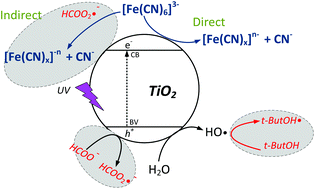当前位置:
X-MOL 学术
›
Photochem. Photobiol. Sci.
›
论文详情
Our official English website, www.x-mol.net, welcomes your
feedback! (Note: you will need to create a separate account there.)
Anoxic photocatalytic treatment of synthetic mining wastewater using TiO2 and scavengers for complexed cyanide recovery†
Photochemical & Photobiological Sciences ( IF 2.7 ) Pub Date : 2018-08-31 00:00:00 , DOI: 10.1039/c8pp00281a L. A. Betancourt-Buitrago 1, 2, 3, 4 , O. E. Ossa-Echeverry 1, 2, 3, 4 , J. C. Rodriguez-Vallejo 1, 2, 3, 4 , J. M. Barraza 1, 2, 3, 4 , N. Marriaga 1, 2, 3, 4 , F. Machuca-Martínez 1, 2, 3, 4
Photochemical & Photobiological Sciences ( IF 2.7 ) Pub Date : 2018-08-31 00:00:00 , DOI: 10.1039/c8pp00281a L. A. Betancourt-Buitrago 1, 2, 3, 4 , O. E. Ossa-Echeverry 1, 2, 3, 4 , J. C. Rodriguez-Vallejo 1, 2, 3, 4 , J. M. Barraza 1, 2, 3, 4 , N. Marriaga 1, 2, 3, 4 , F. Machuca-Martínez 1, 2, 3, 4
Affiliation

|
The wastewater from gold exploitation is well known for the toxic nature of recalcitrant cyanide metallic complexes. In this work the selectivity in the photocatalytic degradation of gold mining wastewater (Fe(CN)63−) using suspended TiO2 with alcoholic and organic acid scavengers in a mini-CPC photoreactor with a 30 W UV-A LED as an artificial source of light was evaluated. The study was done in four stages: 1. load catalyst determination, 2. combination of scavengers in a typical photocatalytic degradation, 3. evaluation of scavenger concentration and 4. kinetic study. The decomposition into CN− and Fe removal of the cyanocomplex were tracked. It was observed that formic acid (FA) and t-butanol (t-ButOH) were the best scavengers for the photocatalytic degradation under anoxic conditions. The best concentrations of acceptors used in the study were 10 mM FA and 10 mM t-ButOH at 20 W m−2 of UV-A power, reaching 80% degradation of Fe(CN)63−, 40% Fe removal and 18 ppm of free cyanide CN release to the liquid phase. The electrical efficiency of oxidation per order (EEo) was increased by about 50% with the addition of scavengers instead of traditional anoxic photocatalytic treatment. It was proved that the photocatalytic decomposition of the Fe cyanocomplex was done through the photoreduction path of the metal complex.
中文翻译:

TiO 2和清除剂对合成采矿废水的缺氧光催化处理,以回收复杂的氰化物†
来自金矿开采的废水因难分解的氰化物金属络合物的毒性而闻名。在这项工作中,在具有30 W UV-A LED的微型CPC光反应器中,使用悬浮的TiO 2与醇和有机酸清除剂,在光催化降解金矿废水(Fe(CN)6 3−)中的选择性的光被评估。该研究分四个阶段进行:1.确定负载催化剂; 2.在典型的光催化降解过程中结合使用清除剂; 3.评估清除剂浓度;以及4.动力学研究。分解成CN -和Fe去除cyanocomplex被跟踪。观察到甲酸(FA)和叔丁醇(t-ButOH)是在缺氧条件下光催化降解的最佳清除剂。在研究中使用的最佳受体浓度为10 mM FA和10 mM t- ButOH在UV-A功率为20 W m -2时,达到80%的Fe(CN)6 3- 3降解,40%的Fe去除和18 ppm的游离氰CN释放到液相中。通过添加清除剂代替传统的缺氧光催化处理,每级氧化的电效率(E Eo)提高了约50%。证明了铁氰基络合物的光催化分解是通过金属络合物的光还原途径完成的。
更新日期:2018-08-31
中文翻译:

TiO 2和清除剂对合成采矿废水的缺氧光催化处理,以回收复杂的氰化物†
来自金矿开采的废水因难分解的氰化物金属络合物的毒性而闻名。在这项工作中,在具有30 W UV-A LED的微型CPC光反应器中,使用悬浮的TiO 2与醇和有机酸清除剂,在光催化降解金矿废水(Fe(CN)6 3−)中的选择性的光被评估。该研究分四个阶段进行:1.确定负载催化剂; 2.在典型的光催化降解过程中结合使用清除剂; 3.评估清除剂浓度;以及4.动力学研究。分解成CN -和Fe去除cyanocomplex被跟踪。观察到甲酸(FA)和叔丁醇(t-ButOH)是在缺氧条件下光催化降解的最佳清除剂。在研究中使用的最佳受体浓度为10 mM FA和10 mM t- ButOH在UV-A功率为20 W m -2时,达到80%的Fe(CN)6 3- 3降解,40%的Fe去除和18 ppm的游离氰CN释放到液相中。通过添加清除剂代替传统的缺氧光催化处理,每级氧化的电效率(E Eo)提高了约50%。证明了铁氰基络合物的光催化分解是通过金属络合物的光还原途径完成的。











































 京公网安备 11010802027423号
京公网安备 11010802027423号